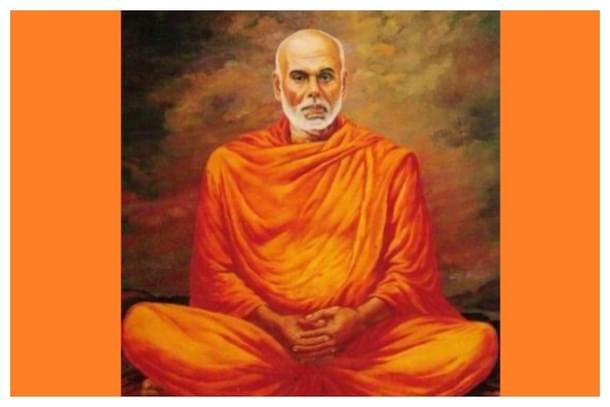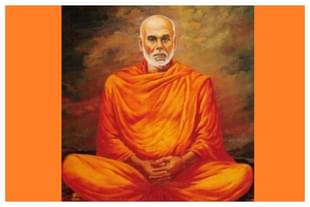Ideas
Sri Narayana Guru - A Holistic Advaitin
Aravindan Neelakandan
Aug 20, 2024, 05:47 PM | Updated 05:47 PM IST
Save & read from anywhere!
Bookmark stories for easy access on any device or the Swarajya app.


The greatness of Sri Narayana Guru and his contribution to Hindu spiritual tradition is multi-dimensional and deep.
The Hindu population in Kerala remains significant primarily due to the mission and vision of Sri Narayana Guru.
While Guru is known mainly as a social reformer, the truth is it was his Vedantic vision that was at the core of his social mission.

Guru was born on August 20, 1854 in the much oppressed Ezahava community. The community's strength lay in the well-preserved and widely spread knowledge of Sanskrit, despite facing oppression.
Thus Nanu, Guru as he was known in his early days, could learn both Tamil and Sanskrit along with his mother tongue Malayalam. This indigenous system of learning lighted a fire of spiritual quest in his heart.
A Practical Kanakadhara Stotram
During his days of spiritual seeking and sadhana, he mingled with common people. He saw their sufferings. He also saw in them virtues of sharing and giving.
When he was doing his sadhana by the coast, the fishermen would give him fish, which he took to an elderly woman. She cooked it and shared her modest meal with him. Saddened by the poverty of the people Guru did not give them just his blessing but taught them how to prepare coconut fibre out of husk, thus augmenting their income.
This was a contemporary reflection of that legend where Adi Shankara blessed a poor woman who gave him a single berry, with prosperity.
As Narayana Guru realised the Vedantic vision, and spread it in society, it naturally clashed with the forces of social stagnation who used religion for their vested interests. This dehumanised large sections of Hindus to the advantage of a few.
'Savarna' Hindus imposed inhumane humiliation on their fellow Hindus, perverting the liberating essence of Hinduism to enslave them under the guise of the varna system. The uncompromising Vedanta of Guru challenged this with spiritual authority.
Temples: Back to Original Sacredness
On the Mahashivaratri night of February 10 of 1888, at Aruvipuram, a small town, Sri Narayana Guru installed a Shiva Lingam for all people to worship it. The angry upper castes confronted him.
Guru calmly told them that the Shiva installed was ‘Ezhava Shiva’.
Today some caste-apologists use this reply to justify caste-based temples. 'If the Dalits want, let them construct their own temples and go there as Sri Narayana Guru did'. But when Guru gave that answer, he was being sarcastic.
Even by the worldview and philosophy of 'Savarna' Hindus, Siva is Brahman and as such does not have any limiting identity and that too of caste.
Guru was showing his opponents their foolishness and hypocrisy by that sarcastic answer.
It showed how 'Savarna' Hindus used caste to imprison what cannot be confined, as it encompasses all that exists.
This is further illustrated by the statement that became inscribed in the temple: ‘Without the prejudices of caste walls and religious hatred, let this be the model abode of worship.’
It wasn't a new temple but a model that all temples should follow, representing an ideal from which ancient sacred sites had strayed.
Sri Narayana Guru brought in true Hindu renaissance in temple worship. The model he envisioned anchored in the Gyana tradition of this land was authentic and adapted to the changing modern world with all its challenges.
In the Sarada temple that he built, he also included educational institutions and library.
A year before his Samadhi, he was to consecrate the sacred idol at Artha Nareeswara temple at at Saktiswaram of Alappuzha district. Modern youth influenced by Protestant values did not want Guru come to an ‘idol worshipping temple’.
The organisers were so depressed that one elderly temple committee member even threatened to take away his life if Guru would not come. Guru did come and found a wonderful solution. He installed a mirror with Pranava and explained that this was symbolic of both ‘Aham Brahmāsmi’ (I am Brahman) and also ‘Tat Tvam asi’ (Thou art that) – the Upanishads Maha Vakyas.
Sri Narayana Guru was the living embodiment of Upanishadic wisdom in which the Divine, both Form and the Formless, is used to experience the Self.
Literary Renaissance
A spiritual giant he was also the one who recognised the literary genius in the young 17 years old Kumaran. Narayana Guru gave spiritual impetus to his poetry by advising him to sublimate the libidinal tendencies that arise in a man into spiritual ones.
Kumaran Asan went on to become the forerunner of modern literary renaissance in Malayalam.

Another notable literary figure inspired by Guru was Mooloor S. Padmanabha Panickar. Known commonly as Mooloor, he met Guru in 1905, an encounter that profoundly influenced his life.
Through his poetry and activism, he championed the abolition of caste-based discrimination, advocating for equality not only between different castes but also within each caste.
When a doyen of Malayalam literature, Kodungallur Kunjikuttan Thambiran, wrote a historico-literary compendium of the language titled Kavi Bharatham and left out important Ezhava contributors, Mooloor came out with an alternative compendium, Kavi Ramayanam. that included all the great contributors to literature, irrespective of their castes.
Mooloor also oversaw the construction of the famous Mezhuveli Anandabuthiswara Temple. The sacred Deity form was consecrated by Sri Narayana Guru himself.

Advaita Vedanta Paramacharya of Tamil Nadu, Swami Chitbavananda was told by Sri Narayana Guru to read Thiruvasagam and write a bhashya on it. To this day the commentary by Swami Chitbavananda on Thiruvasagam is unmatched.
Religious Conversions
The attitude of Guru towards conversion from Hinduism—whether to Christianity or Buddhism‚—showed both caution and understanding.
During an in-depth conversation with Sri C.V. Kunjuraman, a close disciple, who had partially embraced Buddhism, Guru listened empathetically to his reasons for conversion.
He even concurred with some of Kunjuraman’s perspectives before thoughtfully sharing his own insights:
If the religion of those who live in Hindustan is Hinduism, then the religion of Christians and Muslims who presently live in India is also Hinduism. But nobody says so and nobody agrees. Now Hinduism is the common name for the religions indigenous to Hindustan. This excludes Christianity and Islam which came from outside. For this reason, some people say Buddhism, Jainism etc. are also Hinduism. If it is not irrational to call different religions such as Vaidika, Pauranika, Sankhya, Vaisheshika, Meemamsaka, Dvaita, Advaita, Shaiva, Shaktheya and Vaishnava commonly as Hinduism, how is it irrational to call all religions together as “Eka Matam”?
Then Guru referred to the conversation he had with Mahatma Gandhi and affirmatively pointed out Mahatma Gandhi had spoken about every man having an individual religion, just as how ‘how all the branches and leaves were different from one another in a mango tree’.
Guru agreed and further took a Naiyyayika approach and said that for ‘twenty million Hindus, there would be twenty million religions’ and yet people are ‘treated as belonging to a single religion since there are certain aspects that are common in the faith of all people.’
So he elaborated that no religion can exist without basing it on some eternal dharma or truth.’
This was his gentle way of being cautious in conversion.
But Kumaran Asan was openly harsh with respect to conversion, particularly towards Buddhism. This is despite him having written masterful literary works celebrating Buddha.
He pointed out the fallacy of some disciples pressurising Guru to convert to Buddhism explaining that Guru, ‘who had solid foundation in spiritual matters would not change his religion even if compelled by some of the disciples who crave for conversion.’ And he condemned it as ‘disastrous to run after the priests of Ceylon or Tibet leaving a great Teacher.’
While expressing inhibition and caution towards conversion, Guru always encouraged voluntary home-coming of Hindus. His biographer M.K.Sanu writes:
A Thiyya in Kannur had embraced Christianity owing to some family problems. However, he strongly desired to return to Hinduism. But the Thiyyas refused to accept a Christian into their fold. The convert approached the Guru. Guru immediately called his relatives and community leaders and advised them to accept him as a member of the Thiyya community. They accepted his advice and took him back into the community. There were a few Ezhava Christian families near Neyyattinkara in South Travancore. They were Ezhavas by caste and Christians by faith. Even at present, there are some such families in that area. Seeing the prosperity and reform in the community under Guru’s leadership, a lot of people among them wanted to become Hindus again. So they approached Guru. Guru happily welcomed them back to Hinduism.M.K. Sanu, Sree Narayana Guru-Life and Times (Biography: Malayalam), English Trans. Mukundan P.R., Ed. O.V.Usha, (Opendoor Media, 1976), p.189
A Vedic Kavi-Rishi
As a kavi in the tradition of Vedic Mantra-Drishtas, he expressed his spiritual message through poetic Sanskrit and Malayalam. He recontextualised Vedic wisdom into 24 Vedanta Sutras. Here is the twelfth:
Brahmaivaaham tad idam brahmaivaaham asmi.
Translation: Brahman indeed am I. That indeed is the world. Brahman indeed am I.
[Trans. Swami Muni Narayana Prasad]
The following brief excerpt from the commentary on this Sutra by Pujya Swami Muni Narayana Prasad will reveal the immense depth of this Sutra:
It is an affirmation of his enlightened vision of Reality, the vision he has been revealing through perspectives of the undeniable facts of existence and the awareness that knows it to be. He pauses as it to re-assert the nature of the perceiver and the perceived. In this Sutra’s first Brahmaivaahamhe is asserting the subjectivity of the Reality and saying ‘I am that Subject’. With tad idam he is asserting the objectivity of the Reality and saying of the world perceived as object, ‘that object too I am’. Then he puts the two together and says ‘One Absolute Reality only am I.’
The spiritual and historical importance of the ‘Vedanta Sutra’ of Sri Narayana Guru cannot be overstated. Pujya Muni points out:
Sri Narayana Guru is the only latter day interpreter to present the Vedanta philosophy in a fresh and original Sutra form. The Vedanta Sutras of Narayana Guru thus have a unique place in Indian philosophy as the first Sutra expression of Vedanta since Badrayana.
It is quite unfortunate that even Kerala based Vedantic movements do not take this dimension of Sri Narayana Guru to the larger India.
In fact Hindus should initiate saptaham of the life and teachings of Sri Narayana Guru in various parts of India during the month of Guru Puja. Such gratitude is not for the glory of Sri Narayana Guru for he needs neither our remembrance nor our gratitude. But such a gratitude will bless Hindu society with moral and spiritual strength which are singularly lacking in Hindus as a Nation today.





